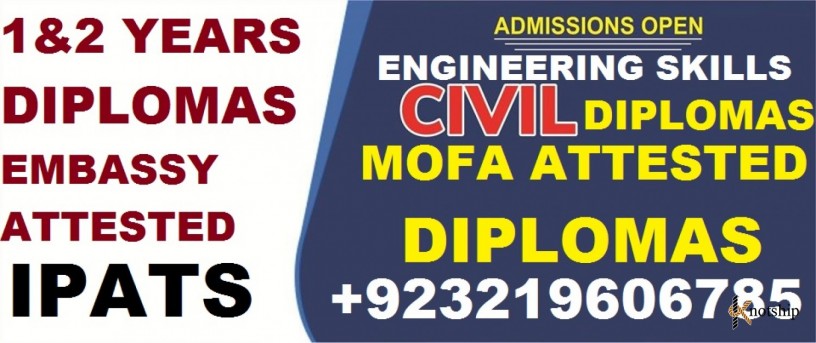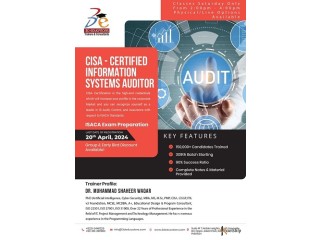Computer Numerical Control (CNC) CNC Training Course Computer individual
4 years ago - Services - Karak - 138 views
Location:
Karak
Price:
Negotiable
Computer Numerical Control (CNC) CNC Training Course Computer
numerically controlled (CNC) 03035530865 Course in Rawalpindi
What is CNC Machining?
CNC machining is a term commonly used in manufacturing and
industrial applications, but exactly what does the acronym CNC
stand for and what is a CNC machine?
The term CNC stands for 'computer numerical control', and the
CNC machining definition is that it is a subtractive
manufacturing process which typically employs computerized
controls and machine tools to remove layers of material from a
stock piece—known as the blank or workpiece—and produces a
custom-designed part. This process is suitable for a wide range
of materials, including metals, plastics, wood, glass, foam,
and composites, and finds application in a variety of
industries, such as large CNC machining and CNC machining
aerospace parts. When speaking in terms of the machine itself,
the CNC machine definition is that it represents the actual
programmable machine that is capable of autonomously performing
the operations of CNC machining. Note the contrast between the
process (CNC machining definition) versus the machine (CNC
machine definition).
Subtractive manufacturing processes, such as CNC machining, are
often presented in contrast to additive manufacturing
processes, such as 3D printing, or formative manufacturing
processes, such as liquid injection molding. While subtractive
processes remove layers of material from the workpiece to
produce custom shapes and designs, additive processes assemble
layers of material to produce the desired form and formative
processes deform and displace stock material into the desired
shape. The automated nature of CNC machining enables the
production of high precision and high accuracy, simple parts
and the cost-effectiveness when fulfilling one-off and medium-
volume production runs. However, while CNC machining
demonstrates certain advantages over other manufacturing
processes, the degree of complexity and intricacy attainable
for part design and the cost-effectiveness of producing complex
parts is limited.
While each type of manufacturing process has its advantages and
disadvantages, this article focuses on the CNC machining
process, outlining the basics of the process, and the various
components and tooling of the CNC machine (sometimes
incorrectly known as a C and C machine)
numerically controlled (CNC) 03035530865 Course in Rawalpindi
What is CNC Machining?
CNC machining is a term commonly used in manufacturing and
industrial applications, but exactly what does the acronym CNC
stand for and what is a CNC machine?
The term CNC stands for 'computer numerical control', and the
CNC machining definition is that it is a subtractive
manufacturing process which typically employs computerized
controls and machine tools to remove layers of material from a
stock piece—known as the blank or workpiece—and produces a
custom-designed part. This process is suitable for a wide range
of materials, including metals, plastics, wood, glass, foam,
and composites, and finds application in a variety of
industries, such as large CNC machining and CNC machining
aerospace parts. When speaking in terms of the machine itself,
the CNC machine definition is that it represents the actual
programmable machine that is capable of autonomously performing
the operations of CNC machining. Note the contrast between the
process (CNC machining definition) versus the machine (CNC
machine definition).
Subtractive manufacturing processes, such as CNC machining, are
often presented in contrast to additive manufacturing
processes, such as 3D printing, or formative manufacturing
processes, such as liquid injection molding. While subtractive
processes remove layers of material from the workpiece to
produce custom shapes and designs, additive processes assemble
layers of material to produce the desired form and formative
processes deform and displace stock material into the desired
shape. The automated nature of CNC machining enables the
production of high precision and high accuracy, simple parts
and the cost-effectiveness when fulfilling one-off and medium-
volume production runs. However, while CNC machining
demonstrates certain advantages over other manufacturing
processes, the degree of complexity and intricacy attainable
for part design and the cost-effectiveness of producing complex
parts is limited.
While each type of manufacturing process has its advantages and
disadvantages, this article focuses on the CNC machining
process, outlining the basics of the process, and the various
components and tooling of the CNC machine (sometimes
incorrectly known as a C and C machine)
Additional Details
Ad Price Type
Paid (Item has Price)






















